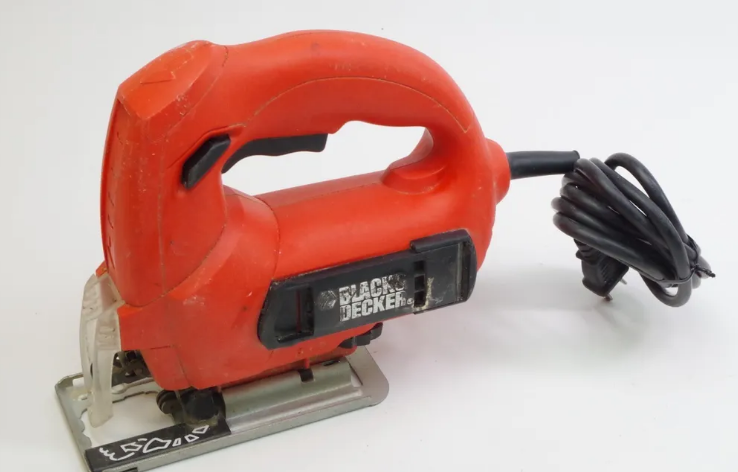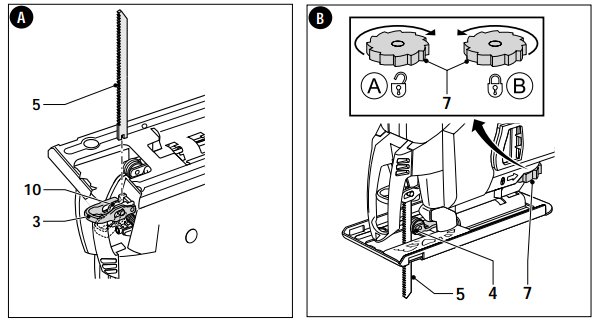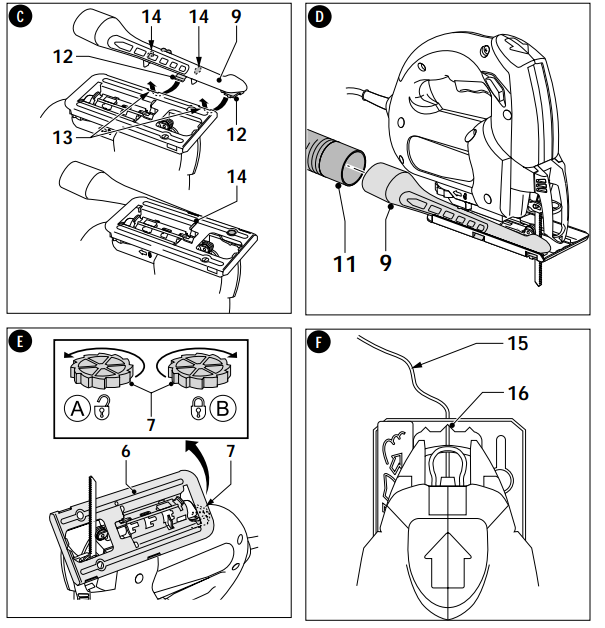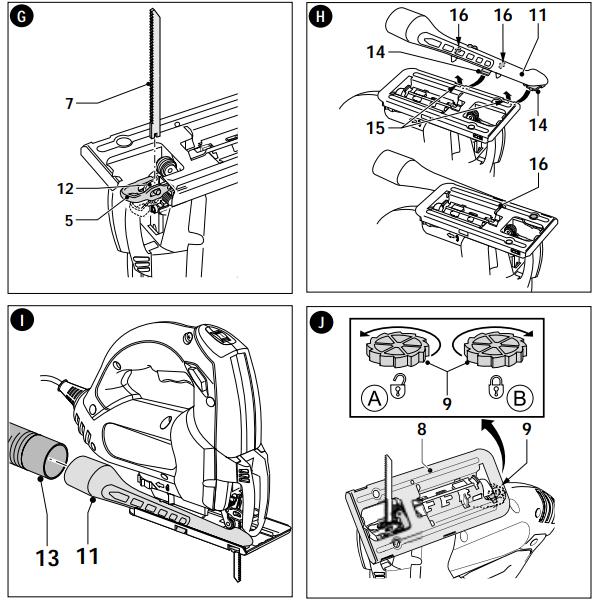Black & Decker JS500 Corded Jig Saw 4 Amp Corded User Manual

SAVE THESE INSTRUCTIONS
Work Area
- Keep your work area clean and well-lit. Cluttered benches and dark areas invite accidents.
- Do not operate power tools in explosive atmospheres, such as in the presence of flammable liquids, gases, or dust. Power tools create sparks that may ignite the dust or fumes. Use in well-ventilated areas only.
- Keep bystanders, children, and visitors away while operating a power tool. Distractions can cause you to lose control.
Electrical Safety
- Double-insulated tools are equipped with a polarized plug (one blade is wider than the other.) This plug will fit in a polarized outlet only one way. If the plug does not fit fully in the outlet, reverse the plug. If it still does not fit, contact a qualified electrician to install a polarized outlet. Do not change the plug in any way. Double insulation eliminates the need for the three-wire grounded power cord and grounded power supply system.
- Avoid body contact with grounded surfaces such as pipes, radiators, ranges, and refrigerators. There is an increased risk of electric shock if your body is grounded.
- Don’t expose power tools to rain or wet conditions. Water entering a power tool will increase the risk of electric shock.
- Do not abuse the cord. Never use the cord to carry the tools or pull the plug from an outlet. Keep the cord away from heat, oil, sharp edges, or moving parts. Replace damaged cords immediately. Damaged cords increase the risk of electric shock.
- When operating a power tool outside, use an outdoor extension cord marked “W-A” or “W.” These cords are rated for outdoor use and reduce the risk of electric shock.
Personal Safety
- Stay alert, watch what you are doing, and use common sense when operating a power tool. Do not use tools while tired or under the influence of drugs, alcohol, or medication. A moment of inattention while operating power tools may result in serious personal injury.
- Dress properly. Do not wear loose clothing or jewelry. Contains long hair. Keep your hair, clothing, and gloves away from moving parts. Loose clothing, jewelry, or long hair can be caught in moving parts. Air vents cover moving parts and should be avoided.
- Avoid accidental starting. Be sure the switch is off before plugging in. Carrying tools with your finger on the switch or plugging in tools that have the switch on invites accidents.
- Remove adjusting keys or wrenches before turning the tool on. A wrench or key that is left attached to a rotating part of the tool may result in personal injury.
- Do not overreach. Keep proper footing and balance at all times. Proper footing and balance enable better control of the tool in unexpected situations.
- Use safety equipment. Always wear eye protection. Dust masks, non-skid safety shoes, hard hats, or hearing protection must be used for appropriate conditions.
Tool Use and Care
- Use clamps or other practical ways to secure and support the workpiece to a stable platform. Holding the work by hand or against your body is unstable and may lead to loss of control.
- Do not force tools. Use the correct tool for your application. The correct tool will do the job better and safer at the rate for which it is designed.
- Do not use the tool if the switch does not turn it on or off. Any tool that cannot be controlled with the switch is dangerous and must be repaired.
- Disconnect the plug from the power source before making any adjustments, changing accessories, or storing the tool. Such preventative safety measures reduce the risk of starting the tool accidentally.
- Store idle tools out of reach of children and other untrained persons. Tools are dangerous in the hands of untrained users.
- Maintain tools with care. Keep cutting tools sharp and clean. Properly maintained tools, with sharp cutting edges are less likely to bind and are easier to control.
Specific Safety Rules
- Hold the tool by insulating gripping surfaces when performing an operation where the cutting tool may contact hidden wiring or its own cord. Contact with a “live” wire will make exposed metal parts of the tool “live” and shock the operator.
- Keep hands away from the cutting area. Never reach underneath the material for any reason. Hold the front of the saw by grasping the contoured gripping area. Do not insert fingers or thumbs into the vicinity of the reciprocating blade and blade clamp. Do not stabilize the saw by gripping the shoe.
- Keep blades sharp. Dull blades may cause the saw to swerve or stall under pressure.
Features
JS500

- Variable speed switch
- Lock-on button
- Saw blade locking lever
- Saw blade support roller
- Saw blade
- Shoe plate
- Shoe plate locking knob
- Saw blade storage compartment
- Dust blower
- Dust extraction adaptor
JS600

- On/off switch
- Lock-on button
- Variable speed control knob
- Orbital action” Turbo” selector
- Saw blade locking lever
- Saw blade support roller
- Saw blade
- Shoe plate
- Shoe plate locking knob
- Saw blade storage compartment
- Dust blower
- Dust extraction adaptor
Illustrations A, and B for Model JS500

C, D, E, F for Model JS500

G, H, I, J, K for Model JS600


USE OF EXTENSION CORDS
Make sure the extension cord is in good condition before using it. Always use the proper size extension cords with the tool – that is, proper wire size for various lengths of cord and heavy enough to carry the current the tool will draw. Use of an undersized cord will cause a drop in line voltage resulting in loss of power and overheating. For proper-size cords see the chart below

MOTOR
Be sure your power supply agrees with the nameplate marking. 120 Volts AC only means your tool will operate on standard 60 Hz household power. Do not operate AC tools on DC. A rating of 120 volts AC/DC means that your tool will operate on standard 60 Hz AC or DC power. This information is printed on the nameplate. Lower voltage will cause loss of power and can result in over-heating. All Black & Decker tools are factory-tested; if this tool does not operate, check the power supply.
SAVE THESE INSTRUCTIONS
Fitting the saw blade (fig. A)
- Hold the saw blade (5) as shown, with teeth facing forward.
- Push the lever (3) downwards.
- Insert the shank of the saw blade into the blade holder (10) as far as it will go.
- Release the lever.
- Adjust the blade support roller as described below
Adjusting the blade support roller (fig. B)
After fitting the blade, you need to adjust the blade support roller (4).
- Turn the locking knob (7) in direction A.
- Slide the blade support roller against the rear of the blade. The blade must be located in the central recess of the roller.
- Turn the locking knob (7) in direction B to lock the shoe plate in place.
Connecting a vacuum cleaner to the tool (fig. C & D)
- Align the dust extraction adaptor (9) with the saw shoe as shown.
- Insert the ribs (12) into the slots (13).
- Rotate the adaptor until it locks into position. Make sure that the ribs (14) are correctly seated.
- Connect the vacuum cleaner hose (11)(not supplied) to the adaptor. Dust extraction is not possible when making bevel cuts.
USE
Adjusting the shoe plate for bevel cuts (fig.E)
The shoe plate can be set to a left or right bevel angle of up to 45°.
- Turn the locking knob (7) in direction A to release the shoe plate (6).
- Pull the shoe plate (6) backward and set it to the required angle. You can use the scale or a protractor to check the angle.
- Turn the locking knob (7) in direction B to lock the shoe plate in place. To reset the shoe plate for straight cuts:
- Turn the locking knob (7) in direction A to release the shoe plate (6).
- Pull the shoe plate backward and set it to an angle of approximately 0.
- Push the shoe plate forward.
- Turn the locking knob (7) in direction B to lock the shoe plate in place. Make sure that the shoe plate is supported by the guide ribs.
Switching On and Off
- To switch the tool on, press the variable speed switch (1). The tool speed depends on how far you depress the switch.
- For continuous operation, press the lock-on button (2) and release the variable speed switch. This option is available only at full speed.
- To switch the tool off, release the variable speed switch. To switch the tool off, when in continuous operation, press the variable speed switch once more and release it.
ASSEMBLY – JS600 ONLY
Fitting the saw blade (fig. G)
- Hold the saw blade (7) as shown, with teeth facing forward.
- Push the lever (5) downwards.
- Insert the shank of the saw blade into the blade holder (12) as far as it will go.
- Release the lever
Connecting a vacuum cleaner to the tool (fig. H & I)
- Align the dust extraction adaptor (11) with the saw shoe as shown.
- Insert the ribs (14) into the slots (15).
- Rotate the adaptor until it locks into position. Make sure that the ribs (16) are correctly seated.
- Connect the vacuum cleaner hose (13) (not supplied) to the adaptor. Dust extraction is not possible when making bevel cuts.
Adjusting the shoe plate for bevel cuts (fig. J)
The shoe plate can be set to a left or right bevel angle of up to 45°.
- Turn the locking knob (9) in direction A to release the shoe plate (8).
- Pull the shoe plate (8) backward and set it to the required angle. You can use the scale or a protractor to check the angle.
- Turn the locking knob (9) in direction B to lock the shoe plate in place.
- To reset the shoe plate for straight cuts:
- Turn the locking knob (9) in direction A to release the shoe plate (8).
- Pull the shoe plate backward and set it to an angle of approximately 0.
- Push the shoe plate forward.
- Turn the locking knob (9) in direction B to lock the shoe plate in place. Make sure that the shoe plate is supported by the guide ribs.
Orbital Action Turbo Selector
- For fast and efficient straight cuts in wood, set the turbo orbital action selector (4) to “max”.
- For accurate straight and curve cutting and a smooth surface finish, set the turbo selector (4) to “min”.
- The turbo orbital action selector (4) can also be set to the middle position between “max” and “min” for a moderate speed of cut and finish. Note: Orbital Action is not recommended when scrolling.
Switching On and Off
- To switch the tool on, press the on/off switch (1).
- For continuous operation, press the lock-on button (2) and release the on/off switch.
- To switch the tool off, release the on/off switch. To switch the tool off, when in continuous operation, press the on/off switch once more and release it.
How to Use the Sightline® Feature (fig.K) – Use a pencil to mark the cutting line.
- Position the jigsaw over the line (17).
Viewing from directly above the jigsaw the line of cut can be easily followed. Should this view be restricted for any reason, the indent (18) can be used as an alternate cutting guide.
HINTS FOR OPTIMUM USE
General
- Use a high speed for wood, a medium speed for aluminum and PVC and a low speed for metals other then aluminum.
Sawing laminates
As the saw blade cuts on the upward stroke, splintering may occur on the surface closest to the shoe plate.
- Use a fine-tooth saw blade.
- Saw from the back surface of the workpiece.
- To minimize splintering, clamp a piece of scrap wood or hardboard to both sides of the workpiece and sew through this sandwich.
Sawing metal
- Be aware that sawing metal takes much more time than sawing wood.
- Use a saw blade suitable for sawing metal.
- When cutting thin metal, clamp a piece of scrap wood to the back surface of the workpiece and cut through this sandwich.
- Spread a film of oil along the intended line of cut.
MAINTENANCE
Use only mild soap and a damp cloth to clean the tool. Never let any liquid get inside the tool; never immerse any part of the tool into a liquid.
IMPORTANT:
To assure product SAFETY and RELIABILITY, repairs, maintenance, and adjustment should be performed by authorized service centers or other qualified service personnel, always using identical replacement parts.
ACCESSORIES
Recommended accessories for use with your tool are available from your local dealer or authorized service center. If you need assistance regarding accessories, please call: 1-800-544-6986.
SERVICE INFORMATION
Black & Decker offers a full network of company-owned and authorized service locations throughout North America. All Black & Decker Service Centers are staffed with trained personnel to provide customers with efficient and reliable power tool service. Whether you need technical advice, repair, or genuine factory replacement parts, contact the Black & Decker location nearest you. To find your local service location, refer to the yellow page directory under “Tools—Electric” or call: 1-800-544-6986.
FULL TWO-YEAR HOME USE WARRANTY
Black & Decker (U.S.) Inc. warrants this product for two years against any defects in material or workmanship. The defective product will be replaced or repaired at no charge in either of two ways. The first, which will result in exchanges only, is to return the product to the retailer from whom it was purchased (provided that the store is a participating retailer). Returns should be made within the time period of the retailer’s policy for exchanges (usually 30 to 90 days after the sale).
Proof of purchase may be required. Please check with the retailer for their specific return policy regarding returns that are beyond the time set for exchanges. The second option is to take or send the product (prepaid) to a Black & Decker-owned or authorized Service Center for repair or replacement at our option. Proof of purchase may be required. Black & Decker-owned and authorized Service Centers are listed under “Tools–Electric” in the Yellow Pages of the phone directory.
This warranty does not apply to accessories. This warranty gives you specific legal rights and you may have other rights which vary from state to state. Should you have any questions, contact the manager of your nearest Black & Decker Service Center. This product is not intended for commercial use.
REFERENCE LINK
https://www.fix.com/models/jig-saw/black-and-decker/id780362/js500-type%201/





